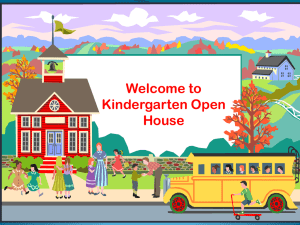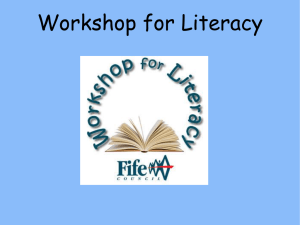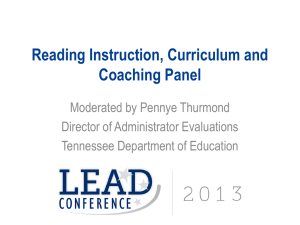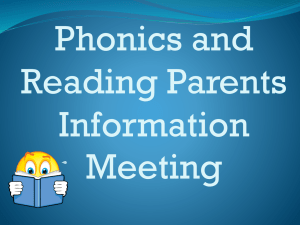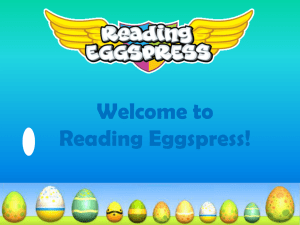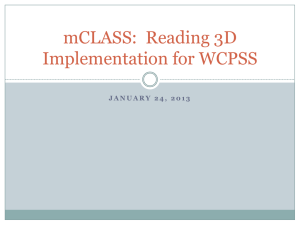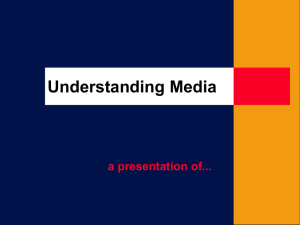SAALED Conference South Africa 2011: ABCs of
advertisement
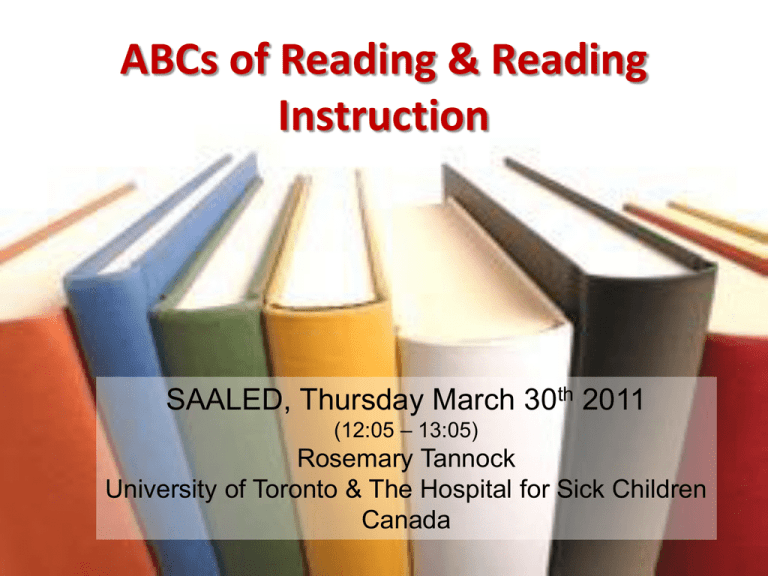
ABCs of Reading & Reading Instruction SAALED, Thursday March 30th 2011 (12:05 – 13:05) Rosemary Tannock University of Toronto & The Hospital for Sick Children Canada Plan for this presentation • Why do many youngsters have difficulty learning to read? • What are the key component skills • How can we help youngsters who are struggling with reading? Proust and the Squid: The Story and Science of the Reading Brain http://itc.conversationsnetwork.org/shows/detail3405.html# “We were never born to read.” Unlike language, reading has no specific genes to set up its circuitry or to dictate its development. Pyramid of Reading Behaviours It took the human species 2000 years of insights from first logographic scripts to first alphabet (system of symbols for each sound) Children are given just 2000 days to gain the same insights! No Genes specific to reading; no “Reading Center” To read, each child must create a new reading circuit from older structures & their connections Development of Reading Neuronal Recycling” for Numeracy & Literacy Existing circuits of neurons - originally designed for vision, language, & cognition – must forge new connections & pathways ◦ Neural circuits & pathways are created through hundreds of exposures (or thousands in the case of dyslexia) to letters, letter patterns, & words - to provide automatized & efficient processing of print What are the implications for education? “ Children are wired for sound, but print is an optional accessory that must be painstakingly bolted on.” - Steven Pinker What must be bolted on…? Automatic Recognition of: Smallest Sounds ◦ Phonemes/phonemic awareness) Letters & Letter Patterns ◦ Grapheme/orthographic awareness Morphology ◦ Structure & form of words Meanings & Word Knowledge ◦ semantics Pragmatic Knowledge ◦ Language in use These skills must be bolted on! letter recognition 50-150 ms Connecting letters-sounds; orthography-phonology 100-200 ms 200-500 ms Word knowledge; ~ 200 ms onwards processing Syntax/morphology “Every word has 500 ms of fame” (P&S p.145) Timeline of Fluent Reading: role of attention from Maryanne Wolf: Proust & the Squid, 2007, p.145 At the heart of reading, 200 milliseconds allow us “time to think new thoughts”. Slow decoding, inattention, & poor oral language, all have negative impact on reading comprehension The Heart of Expert Reading Normal Readers Visual Recognition 0-100 MSEC Dyslexic Readers Delay Word Specific Activation 150 MSEC Delay Phonological Processing 180-300 MSEC Delay Semantic Processing 200-500 MSEC Delay National Reading Panel (2000): Teaching Children to Read. Washington, DC: NICHHD Clearing House 1. Phonemic/phonological awareness 2. Alphabet principle 3. Fluency 4. Vocabulary 5. Text comprehension What are the 5 critical domains for reading assessment & instruction? An oral language skill that allows us to detect and manipulate sounds at the phoneme, syllable, or word level ◦ Includes phonemic awareness (the ability to identify & manipulate individual sounds in spoken words) ◦ Does not involve written letters Phoneme: smallest unit of speech that signifies a differences in word meaning. English has 40 – 44 phonemes 1. What is phonological awareness? Understanding the relationships between phonemes & graphemes ◦ Lack of phonemic awareness impedes development of alphabetic principle ◦ Mastery of the alphabetic principle is required to read words Grapheme: part of the system of marks that make up printed language, which is called ‘orthography’ English speech sounds are represented by letters & groups of letters, called graphemes English has 40-44 phonemes but 220 graphemes The problem: 1 phoneme can be spelled with different graphemes; I grapheme can represent more than 1 phoneme 2. Alphabet principle How many phonemes are there in the word “box”? 4 phonemes: the single letter ‘x’ is comprised of 2 sounds (phonemes: /k/ /s/) What are 2 most important phonological awareness abilities for reading? Blending (pushing the sounds together) Segmenting (pulling the sounds apart) Self-test Sound Blending Start with speech sounds that can be sustained (/s/ /m/) Progress from words with 2 speech sounds to 3, then 4 Demonstrate, model, practice Progress to practice with words with regular phoneme-grapheme correspondence Segmentation Start with compound words (e.g. raincoat) Progress to words with 2 syllables Then onset-rimes Finally to phonemes (words with 2 speech sounds, 3, then 4) Progress to practice with words with regular phoneme-grapheme correspondence Teaching sound blending & segmentation Sounding out (phonological awareness) Reading Mastery is a direct instruction program that aims to provide students in kindergarten through grade 6 with explicit and systematic instruction in English language reading. The program offers fast-paced and interactive lessons and includes placement assessment and a continuous monitoring system. Know the sounds Blend the sounds (slowly without stopping) mmaaann Read the word (say the blended sounds fast) man Lovett: LRDP/HSC: Derived from Reading Mastery Classic I/II/Fast Cycle 2003 Vowel Alert glow cow Adapted from Lovett et al: Empower™ Reading (The Hospital for Sick Children 2006 Sound Blending Start with speech sounds that can be sustained (/s/ /m/) Progress from words with 2 speech sounds to 3, then 4 Demonstrate, model, practice Progress to practice with words with regular phoneme-grapheme correspondence Segmentation Start with compound words (e.g. raincoat) Progress to words with 2 syllables Then onset-rimes Finally to phonemes (words with 2 speech sounds, 3, then 4) Progress to practice with words with regular phoneme-grapheme correspondence Teaching sound blending & segmentation Parts of an English syllable: An ‘onset’ is the beginning consonant letters A ‘rime’ is the part of a syllable that contains the vowel and all that follows it What is the rime of ‘swim’ ? And “birthday”? Onset-rime self-test Onset-rimes: set of 37 rimes from which 500 primary words can be taught ack ain ake ale all ame an ank ap ash at ate aw ay eat ell est ice ick ide ight ill in ine ing ink ip ir ock oke op or ore uck ump ug unk Wylie & Durrell 1970: cited in Wendling & Mather (Eds), Essentials of evidence-based academic interventions (2009) NY: Wiley & sons Line separates onset-rime Volunteer needed to read a word! Periventricular nodular heterotopia What does this word mean? Periventricular nodular heterotopia is a common malformation of cortical development in which the migration of developing neurons destined for the cerebral cortex is abbreviated. Associated with seizures & reading deficits Morphemes Matter Morpheme: the smallest unit of meaning in a language The word ‘reddened’ has 3 morphemes, which signal: its root = red; its verb class = - en; past tense = - ed How many morphemes in the word: “replacement ” ? What is a morpheme? Self-test Peeling-off tree able Adapted from Lovett et al: Empower™ Reading (The Hospital for Sick Children 2006 Fluency: “the ability to read connected text rapidly, smoothly, effortlessly, & automatically with little conscious attention to the mechanics of reading (e.g., decoding)” Fluency requires an appropriate rate, high accuracy, and appropriate expression Signs of poor reading fluency Reads word-by-word with limited expression or prosody, ignores punctuation, does not divide sentences into meaningful phrases 3. Reading Fluency Slow readers… Expend more energy than peers on trying to identify individual words Read less text & have less time to remember, review, or comprehend the text Have trouble retaining parts of the text in memory & so less likely to integrate those segments with other parts Effects of slow reading on reading performance > 1 error per 10 words read: Student should have accuracy of 90-94% on the material used for reading fluency instruction Instruction should focus on building ACCURACY < 1 error per 10 words read: Instruction should focus on building FLUENCY When to focus on Reading Fluency Help develop automatic word recognition ◦ 1-minute speed drills for reading word list Provide an explicit model of fluent reading ◦ Model reading, echo reading, choral reading Multiple readings (3 to 4) of text with corrective feedback on missed words Explicit instruction & practice in recognizing larger orthographic units Establish performance criteria for reading fluency & monitor progress ◦ e.g., 40% higher than current reading rate Effective instruction for reading fluency Grades 1 & 2: 30 correct wpm Start-Grade 3: 40 correct wpm Mid-Grade 3: 60 correct wpm Grade 4 onwards: 80 correct wpm Expected reading rate for connected text in Grade 4: 135 words per minute Word reading rate for 1-minute speed drills Help develop automatic word recognition Provide an explicit model of fluent reading ◦ Model reading, echo reading, choral reading Multiple readings (3 to 4) of text with corrective feedback on missed words Explicit instruction & practice in recognizing larger orthographic units Establish performance criteria for reading fluency & monitor progress ◦ e.g., 40% higher than current reading rate Effective instruction for reading fluency A process by which readers construct meaning by interacting with the text through the combination of: Prior knowledge & previous experience Information in the text The stance readers take in relationship to the ideas presented in the text 5. Text Comprehension Characteristics of Good Readers Poor Comprehenders Limited vocabulary Poor attention Poor working memory Lack persistence Poor or fluent decoding ◦ Predicting Do not use strategies ◦ Questioning when reading ◦ Summarizing Do not use prior ◦ Visualizing knowledge Uses prior knowledge Do not monitor their Monitors understanding understanding Adjusts reading rate Reads actively Reads for a purpose Previews text Uses a variety of strategies when reading Text comprehension A. Vocabulary instruction B. Seven effective comprehension strategies: 1. Comprehension monitoring 2. Question answering 3. Question generating 4. Summarization 5. Cooperative learning 6. Graphic & semantic organizers 7. Story structures Effective instruction in text comprehension INSERT “I knew that” confirms what you already know “I thought differently” Contradicts what you thought “I don’t understand this” Confuses you “I didn’t know that” Something new Comprehension monitoring strategy Reading comprehension strategies During: Step 3: Before: Step 2: Step 1: Effective reading comprehension strategies After: Visualize A final reading. Questions: Preview the layout. Ex. read down a column, not across columns. Captions go with pictures. Quotations mean conversation. Think aloud , make connections, inferences. Ex. Give sticky notes to attach "I agree", "This reminds me of..." Stop to summarize at end of paragraphs. Vocabulary: predict, confirm and pronounce Make predictions. Revise predictions. Activate prior knowledge. Direct (answers are in the story/book) Indirect (provoke thought "why") Personal questions (expand answer based on experience). Use graphic organizers. Think-aloud reading comprehension strategies Explicitly teach “think-aloud” reading comprehension strategies, • • Create posters as classroom prompts. Visualize “I can see it clearly…” Connect “That reminds me of when…” Purpose “I want to find out…” • Promote ongoing use of these strategies across the curriculum, •At any time that you engage the students in a reading task, the students may raise their hand and voice a “think-aloud”. - Prediction “I think I know what will happen…” Vocabulary “What does ____ mean?” Inference “I figured it out!” Collaborative Strategic Reading Activate prior knowledge, consists of brainstorming& making predictions prior to reading • Preview Monitor understanding during reading, & use fix-up strategies when fail to understand text. Click indicates understanding. Clunk indicates not understanding • Click and Clunk • Identify main ideas during reading Get the Gist Wrap up (Limit to 10 words per idea). • Generate questions & review important ideas in the text. 2 Activities: Generating questions; reviewing. Get the Gist (Klingner, Vaughn, Schumm 1998) ◦ To help students understand the concept of the ‘main idea’ Teach the strategy using a picture or cartoon first, then progress to a paragraph 1. who or what the paragraph is about? 2. what is the most important information about the ‘who’ or the ‘what’ in the paragraph? 3. Say it in a statement of 10 words or less Summarization Collaborative Strategic Reading (CSR) The collaborative strategic reading strategy has been shown to improve reading comprehension for all students outcomes in general education classrooms (Klingner, et al, 1998, 2004; Hitchcock, et al, 2009; Vaughn et al, 2001). CSR components - combines modified reciprocal teaching and cooperative learning Teacher led component - teacher explicitly teaches and models the following 4 comprehension strategies for students CSR Cooperative Learning Group Component Student led component Students will work together in groups of 4 taking turns in roles of Leader, Clunk Expert, Gist Expert and Announcer. In roles, the students discuss and apply strategies while reading sections of the text aloud to group. A number of materials may be used including: Clunk cards, Cue cards, Learning log, Timers, & Score cards. To support a student’s reading comprehension needs this strategy will be implemented with a small group of students for one school term. http://www.ncset.org/publications/viewdesc.asp?id=424 RAVE-O: POSSuM Phonological Orthographic Semantic processes processes processes Syntactic processes Morphological processes The goal of RAVE-O is to simulate in our teaching what the brain does when it reads a single word, a paragraph, a text. RETRIEVAL, AUTOMATICITY, VOCABULARY, ELABORATION, ORTHOGRAPHY (RAVE-O) Wolf, M. et al (2003) J. Learning Disabilities 33:322-324 Major RAVE-O Premise The more you know about a word, the better and faster you can read and comprehend it. FAN “fan” as Noun, Verb Orthographic Component f an Train the visual system to recognize letter patterns (chunks) and words Connect visual representations to corresponding sounds Develop speed in recognition and retrieval Understand and use the linguistic structure of English words to store and retrieve orthographic forms From RAVE-O Reading program (MaryAnne Wolf) Morphological Component Rapid recognition of morphemes added to words like fan Automatic access to meanings of morphemes Contributes to rapid recognition of words and to semantic development Empower students to attack new and large words. Continuum of knowledge about every word Multiplicity Words of Meanings with richer “semantic neighborhoods” are read more quickly and easily! Semantic Component Who did what to whom Awareness of syntactic uses of words in text Understanding of grammatical relationships in language Pivotal for comprehension of connected text and semantic development Sam Sleuth tracked the tracks by the track. Syntactic Component Key Instructional Features of PHAST Track Programming Using prior knowledge Teaching prerequisite knowledge Preskill mastery Teacher modelling Scaffolded instruction Metacognitive strategy-based approach Metacognitive dialogue training (“self-talk”) Attributional retraining ----Success Word Identification Strategy Training (WIST) 1. Analogy: limerick (him)(her)(kick) 2. Seek the Part You Know (SPY): dogmatic dog mat ic 3. Vowel Variations: 4. Peeling Off: unrelenting head bead break seam? great? breath? (un)(re)lent(ing) Using the 5 PHAST Strategies Peeling Off Sound It Out Rhyming Vowel Alert SPY CHECK SCORE Choose: The best strategy Paired-Activity Use: The strategy correctlyTry it yourselves! Check: Each step—”How am See I doing?” worksheet Score: The result—”I did it!” Lovett et al: Empower™ Reading (The Hospital for Sick Children 2006 Lovett et al: Empower™ Reading (The Hospital for Sick Children 2006 Using the Game Plan Step 1. CHOOSE: "My Game Plan is to first use Peeling Off. Then I am going to use the Rhyming Strategy and look for spelling patterns I know.” Step 2. USE: "I am Peeling Off un and ing. My next Game Plan is Rhyming. I see the spelling pattern a-c-k. The key word is pack. If I know pack, then I know stack.” Step 3. CHECK: : "I have to stop and think about whether I’m using the strategy(ies) properly. Is it working? Yes, I’ll keep on going. I will put all the parts together—un-stack-ing.” Step 4. SCORE / RE-CHOOSE: "The word is unstacking. I scored! I used Peeling Off and Rhyming to help me figure out this word and they worked." (If the strategy did not result in a real word, the child begins again at Step 1, and chooses another strategy to try.) Lovett et al: Empower™ Reading (The Hospital for Sick Children 2006 Key message • Learning to read is not a natural act – students need brief but explicit instruction in all of the 5 key domains every day


